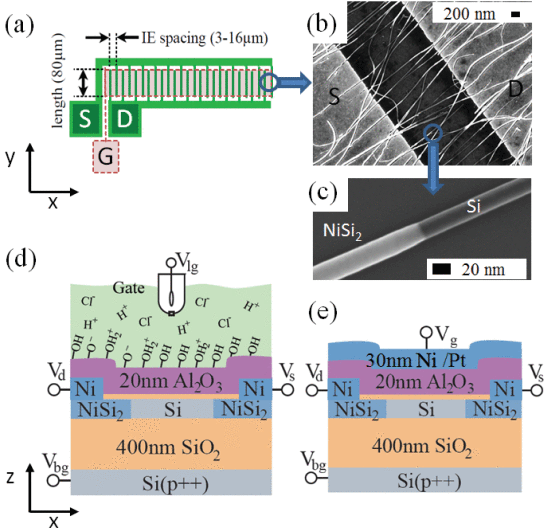Parallel arrays of silicon nanowire transistors are novel types of transducers under study for chemical and biochemical sensing that exploit the high surface-to-volume ratio of nanowires for sampling of low analyte concentrations and yet provide high output conductance. To investigate the applicability and practical sensitivity of parallel nanowire sensor devices, here, we study their signal-to-noise behavior. Parallel arrays of nominally un-doped Si-nanowires with intruded Ni silicide contacts were characterized by capacitance-voltage, current-voltage, and noise measurements. The power spectral density (PSD) shows a high noise level, which is strongly gate-voltage-dependent. The normalized PSD decreases with the square root of the amount of channel charge, which indicates that the 1/f -noise is uncorrelated. Therefore, Hooge's model can be applied, and alpha H between 7E-1 and 3E-2 is extracted. The input-referred voltage noise of 100 mu VHz(-0.5) and a charge noise of 1000 eHz(-0.5) are obtained at 1 Hz for parallel arrays of approximately 100 nanowires with a 7.4 mu m long conduction channel. It is found that the smallest input referred noise level is obtained when operating the device directly at the threshold voltage V-th independent of the device gate length. Using Al2O3 as ion-sensitive dielectric, the presented devices are employed as pH-sensors. It is found that the Ag/AgCl reference electrode is adding a large level of correlated drift, when used in continuous voltage sweeping mode, which dominates the low-frequency noise.

Parallel arrays of silicon nanowire transistors are novel types of transducers under study for chemical and biochemical sensing that exploit the high surface-to-volume ratio of nanowires for sampling of low analyte concentrations and yet provide high output conductance. To investigate the applicability and practical sensitivity of parallel nanowire sensor devices, here, we study their signal-to-noise behavior. Parallel arrays of nominally un-doped Si-nanowires with intruded Ni silicide contacts were characterized by capacitance-voltage, current-voltage, and noise measurements. The power spectral density (PSD) shows a high noise level, which is strongly gate-voltage-dependent. The normalized PSD decreases with the square root of the amount of channel charge, which indicates that the 1/f -noise is uncorrelated. Therefore, Hooge's model can be applied, and alpha H between 7E-1 and 3E-2 is extracted. The input-referred voltage noise of 100 mu VHz(-0.5) and a charge noise of 1000 eHz(-0.5) are obtained at 1 Hz for parallel arrays of approximately 100 nanowires with a 7.4 mu m long conduction channel. It is found that the smallest input referred noise level is obtained when operating the device directly at the threshold voltage V-th independent of the device gate length. Using Al2O3 as ion-sensitive dielectric, the presented devices are employed as pH-sensors. It is found that the Ag/AgCl reference electrode is adding a large level of correlated drift, when used in continuous voltage sweeping mode, which dominates the low-frequency noise.
